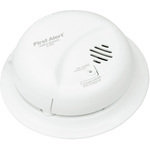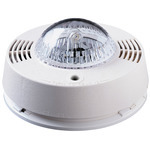Smoke, Carbon Monoxide, and Explosive Gas Alarms
Smoke, carbon monoxide, and gas alarms are important safety products for any family home and business. They provide early warnings for fires, carbon monoxide leaks, and propane or natural gas leaks.
Why You Need Carbon Monoxide Detectors
A "silent killer," carbon monoxide (CO) gas is odorless, tasteless, and invisible. Carbon monoxide poisoning is one of the leading causes of poison related deaths in America. CO gas is released into the air when burning wood, oil, propane, charcoal, or natural gas. In most situations, it dissipates before it becomes concentrated enough to pose a health risk, but gas leaks in your home, RV, or garage can be fatal.
Why You Need Smoke Detectors
When a fire occurs, every second is crucial. The shrill alarm of a smoke detector will wake you from a sound sleep and can easily be heard throughout several rooms. Smoke detectors can alert to the presence of a fire before you can smell smoke or see flames.
Why You Need Explosive Gas Alarms
Explosive gas alarms alert to unsafe amounts of explosive gases in the air. They typically detect propane or natural gas (methane) and go off if levels become concentrated enough to pose a safety hazard. These alarms are a must have in any home or business that use gas appliances, water heaters, fireplaces, and furnaces.
Where to Install Carbon Monoxide, Smoke Detectors, and Explosive Gas Alarms
Be mindful of local fire codes and check state, municipality, and industry requirements for guidance on the installation of CO, gas, smoke detectors. Some may have stricter regulations. For example, California requires tamper-proof smoke detectors. Safety industry experts recommend that CO and smoke detectors be placed on every floor of a building and in the following rooms:
- 5-20 ft. from each furnace, water heater, or fireplace
- Bedrooms
- Hallways
- Living Room
- Kitchen
- Laundry room
- Basement
- Garages
An explosive gas alarm should be installed near appliances, water heaters, and furnaces that use propane or methane. In situations where smoke and carbon monoxide detectors are required, combination smoke/CO units are a smart purchase. In addition to this list, always check the local fire code as each state and municipality may have unique rules.
Are Your Detectors Still Effective?
Smoke, gas, and carbon monoxide detectors become less effective over time. From 2009 to 2013, smoke detectors were present, but failed to operate in 8% of reported fires, resulting in a 21% fatality rate. Even if the alarm sounds when tested, years of built-up smoke, grease, dust, and other debris can coat the alarm's sensor and lessen its ability to detect a fire or gas leak in a timely manner. Because of this, the National Fire Protection Agency (NFPA) recommends replacing the entire unit once every 10 years even if you've been diligent about replacing the batteries.
Decade Long Protection: Tamper-Proof Smoke Detector
Never change the batteries again! First Alert's smoke and carbon monoxide detectors are available with sealed 10-year lithium batteries. California state law requires these tamper-proof designs for all smoke and carbon monoxide detector replacements. When the low battery chirps, simply replace the unit for another decade of worry-free protection. This is the best smoke detector for apartment buildings and rental homes, as many states hold the landlord liable for the upkeep, even when residents fail to replace the battery or disconnect the unit.
Should You Choose Battery-Operated or Hard-Wired?
Most importantly, check the regulations in your area. Homes built before 1992 generally aren't required to have hard-wired smoke detectors, and California requires 10-year tamper-proof, battery-operated detectors. Because hard-wired alarms can be connected, a fire on the first floor can trigger an alarm on the second floor, giving you advanced warning to get out of the house if you're unable to hear the alarm over a TV or stereo. Just remember that hard-wired alarms have a battery backup that needs to be tested regularly and replaced periodically. The battery backup is designed to sustain power to the device in the event of an outage.
Interconnectivity and Retrofit Accessories
Detectors need to be mounted in locations to sound at the first sign of smoke or carbon monoxide. For the elderly, vision or hearing impaired, additional auxiliary warning devices should be mounted closer to the bed and easily visible from other places in the room. Relay modules can activate additional warning devices such as externally mounted bells, sirens, or stairway lighting.
FAQs for Smoke, Carbon Monoxide, and Explosive Gas Alarms
Here are some of the most frequently ask questions about smoke alarms, carbon monoxide alarms, and explosive gas alarms.
What triggers a smoke alarm?
- Smoke alarms are triggered when the sensors detect smoke in the air. There are several different types of smoke alarms, each designed to detect a different type of fire. Some are better at detecting flaming fires that spread quickly, while others detect smoldering fires that might not have visible flames.
What triggers a carbon monoxide alarm?
- A carbon monoxide alarm can be triggered by a variety of things. The most common triggers are malfunctioning gas appliances, air leaks, and a lack of indoor ventilation.
What are the signs of a carbon monoxide leak?
- Common signs of of a carbon monoxide leak include soot marks around appliances, persistent condensation on windows near gas appliances, visible smoke or the smell of exhaust fumes, trouble keeping pilot lights lit, gas-burning appliances have a yellow or flickering flame, and instances of unexplained dizziness, nausea, headaches, or confusions.
What should I do if my explosive gas alarm goes off?
- If your gas alarm goes off, evacuate the premises immediately and do not use any electrical switches or phones. Once you are safely away, contact your local fire department.
Where should I mount my explosive gas alarm?
Explosive gas alarms designed for propane should be mounted on the wall near the floor since propane is heavier than air. Alarms designed for methane (natural gas) should be wall mounted closer to the ceiling. If you have a combination explosive gas alarm (both propane & methane), it should be mounted more in the middle.
Do smoke, gas, and carbon monoxide alarms work during power outages?
- Many of these alarms have a battery backup that ensures they will continue to work if the power goes out. The batteries should be tested regularly to ensure they are working.
What causes nuisance alarms?
Nuisance alarms can be caused by a variety of factors. False alarms for smoke, gas, and CO detectors can be caused by insects, dirt & dust, steam, and humidity. Low batteries or faulty sensors can also cause nuisance alarms. Make sure your alarms are in the proper location and make sure they are free of dirt, dust, and cobwebs. You should also test your unit regularly and replace batteries as needed. The NFPS recommends that smoke and CO alarms be replaced every 10 years. Most gas alarms should be replaced every 5 to 7 years.




